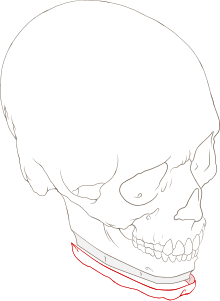Chin Wing
As Chin Wing ( engl. : Chinese "chin"; wing "wings") is an operational method in the lower jaw understood that the correction of aesthetic problems of the lower face at the lower jaw dislocations serves. It is an osteotomy (bone cut) of the lower jaw margin, which was first described in this way in 2009 by Albino Triaca.
The original name given in the first publication was Mandibula wing osteotomy , derived from the wing-shaped bones. Since the method is used especially to correct disorders of the chin shape , the term Chin Wing has become established. During the operation, a circular, vertical-tangential division of the lower jaw margin takes place without changing the jaw bearing the teeth and without affecting the temporomandibular joint .
Areas of application
The method is used when the lower jaw is reclined with a receding chin, an unfavorable shape of the lower jaw edge and angle with a negative impact on the muscle tension in the mouth area , when the lower jaw is shifted forward, as well as lower jaw asymmetries . It complements and expands the existing procedures for jaw osteotomies ( e.g. LeFort I osteotomy , sagittal cleavage according to Obwegeser , segment distractions). These are primarily available to correct dysgnathias , but also secondarily to change the shape of the facial contours, but always affect the jaw bearing the teeth with changes in the bite position and have an influence on the temporomandibular joint . With this new type of osteotomy, the prominence of the chin can be influenced sagittally and transversely (viewed in profile and from the front) and the lower jaw edge and the jaw angle area can be consciously emphasized. A divergence of the lower jaw contour, the relationship between the ascending branch of the lower jaw and the body of the lower jaw, can be changed independently of the existing jaw movement. This surgical method also simplifies the correction of a lower jaw asymmetry without having to fear negative consequences for the temporomandibular joints.
Another advantage is the postoperative normalization of the muscle tension in the chin / mouth area , which is necessary to achieve a sufficient and relaxed mouth closure. This is important for the aesthetic profile, but above all it eliminates the constantly increased muscle tone (state of tension of the muscles in the area of the mouth) on the dentition , which can be partly responsible for the occurrence of tooth misalignments (see also myofunctional disorder (orofacial) ). Any existing mouth breathing with the increased risk of infections of the upper respiratory tract can also be favorably influenced.
Surgical procedure
The procedure is performed from the mouth (intraorally), with a vertical osteotomy of the entire lower jaw edge from jaw angle to jaw angle. It is important that the periosteum is not detached caudally (on the lower edge) of the osteotomy in order to allow further blood flow to the bony wing. The bone brace obtained with this technique remains firmly attached to the soft tissues and, depending on the question, can be divided into different sections and moved in practically all levels before it is fixed in its final position with screws and osteosynthesis plates. With a standard preoperative imaging (preferably a digital volume tomography ) it can be ensured that the Nn. alveolares inferiores or Nn. mentally are reliably spared.
The Chin Wing method can usually be combined with methods for changing the upper jaw in one operation without any problems if there are multiple changes in the face and dysgnathia and must be corrected.
literature
- A. Triaca, R. Minoretti, N. Saulacic: Mandibula Wing Osteotomy for correction of the mandibular plane: a case report . In: British Journal of Oral & Maxillofacial Surgery . tape 48 , 2010, p. 182-184 , PMID 19800718 .
- A. Triaca, D. Brusco: Possibilities of influencing the facial soft tissues through skeletal movements . In: Journal for Aesthetic Surgery . tape 3 , no. 4 , 2011, p. 137-141 , doi : 10.1007 / s12631-011-0125-4 .
